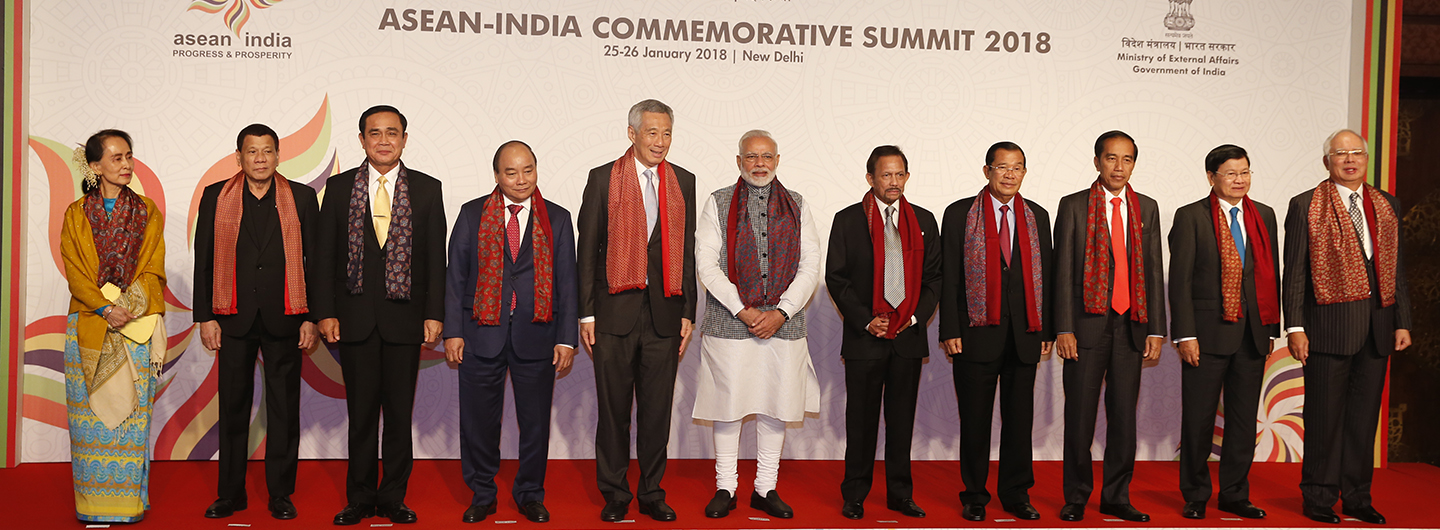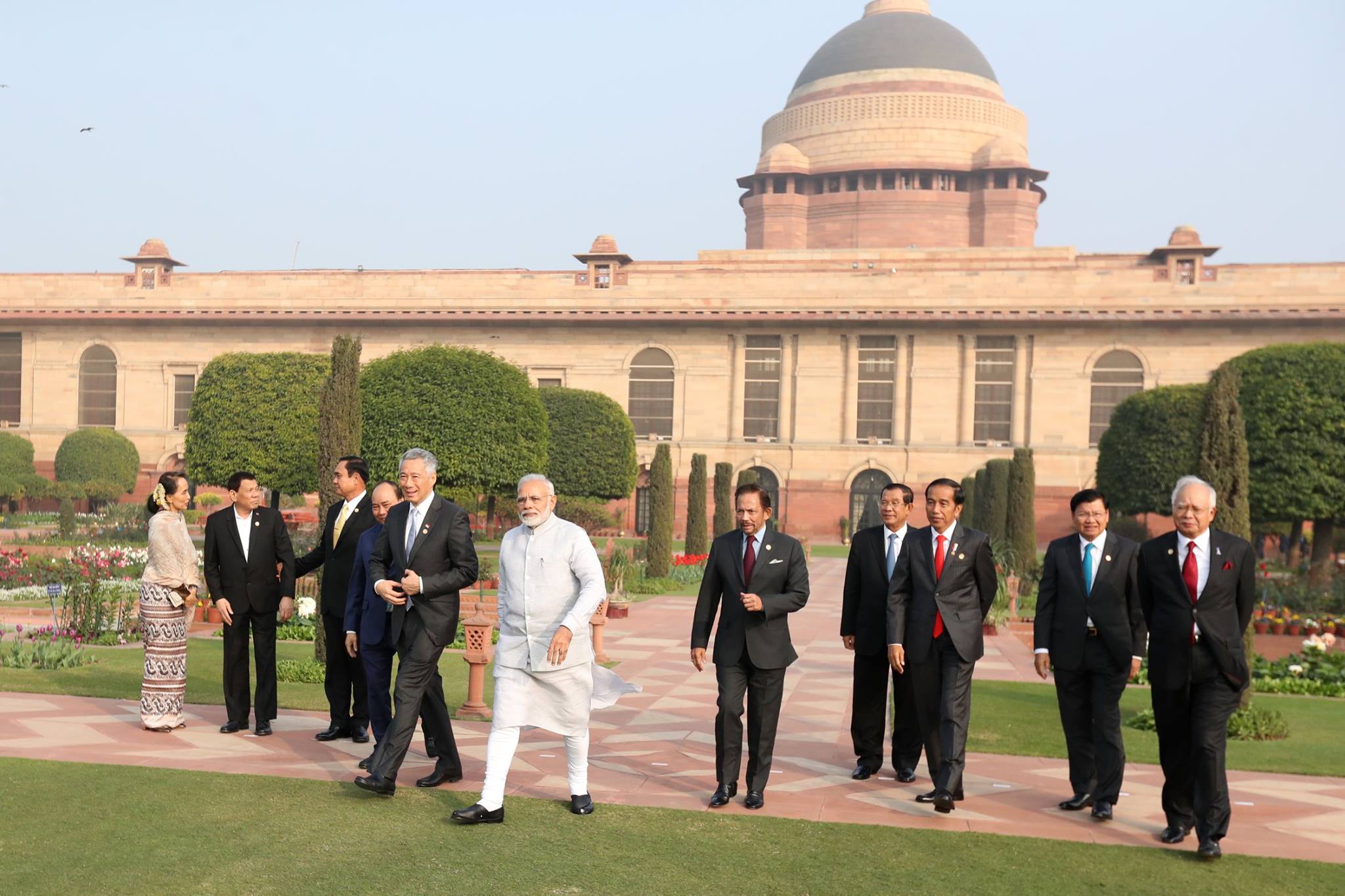Prime Minister Lee Hsien Loong just ended his trip to Delhi, India, where he co-chaired the ASEAN-India Commemorative Summit, along with India's Prime Minister Narendra Modi.
He was there, of course, with the other nine ASEAN leaders.
 Look at everyone standing in a row, so nice. And PM Lee so happy. (Photo via PMO website)
Look at everyone standing in a row, so nice. And PM Lee so happy. (Photo via PMO website)
The summit, which also marks 25 years since India became an ASEAN dialogue partner, was held over two days (Jan. 25 to 26).
Now, perhaps because he knows how little most Singaporeans know or bother about ASEAN and India, much less our relations and how they're going, PM Lee decided he needed to explain how important they are to us and why we should care.
And so, he wrote an op-ed titled "ASEAN and India: 25 Years and Beyond", which calls for both ASEAN and India to take this relationship forward by enhancing trade, investments and connectivity.
So good it was, it seems, that Modi praised it as "a wonderful article" in a tweet:
A wonderful article by @ASEAN Chair Singapore’s PM, Mr. @leehsienloong. It beautifully covers the rich history, robust cooperation and promising future of India-ASEAN relations. https://t.co/FPGfI1eLbj
— Narendra Modi (@narendramodi) January 25, 2018
Here are the highlights of what he wrote, because we know you're like us and are too lazy to wade through the whole thing:
1. India and Southeast Asia go way back
India's ties with Southeast Asia date back more than 2,000 years, and trade between India and countries like Cambodia, Malaysia and Thailand is well-documented.
He also noted that Southeast Asian cultures have been deeply influenced by India — even ours:
"The Ramayana is embedded in many Southeast Asian cultures, including in Indonesia, Myanmar and Thailand.
Singapore’s Malay name is Singapura, derived from Sanskrit and meaning ‘lion city’."
[related_story]
2. ASEAN-India relations now have never been better
On the 20th anniversary of ASEAN-India relations in 2012, we elevated them further to what PM Lee calls a "strategic partnership".
"Today, ASEAN and India enjoy multi-faceted cooperation across ASEAN’s political-security, economic and socio-cultural pillars.
Prime Minister Narendra Modi’s ‘Act East’ policy and 3-C (Commerce, Connectivity, Culture) formula for strengthening engagement with ASEAN speaks to our broad-based cooperation.
We have around 30 platforms for cooperation, including an annual Leaders’ Summit and seven Ministerial Dialogues. India has participated actively in ASEAN-led platforms including the ASEAN Regional Forum, the ASEAN Defence Ministers’ Meeting Plus, and the East Asia Summit."
He also mentioned that ASEAN-India trade volume has increased from US$2.9 billion in 1993 to US$58.4 billion in 2016, while various programmes are in place to help foster closer people-to-people relations.
"Through these platforms, our youth, academics and businessmen get to meet, learn and deepen ties."
3. 3 promising areas of partnership between ASEAN and India
Here they are, summarised:
-
Trade and investment
We've currently got the ASEAN-India Free Trade Area (AIFTA), but PM Lee hopes we will be able to work out a stronger Asian market by getting up and running a "high quality" Regional Comprehensive Economic Partnership that can be even better than the AIFTA.
If we succeed, our combined market will make up half the world's population and a third of its GDP, and if we can iron out our rules and regulations to match up, investments between India and ASEAN will definitely expand.
-
Land, air, maritime and digital connectivity
PM Lee acknowledged India's efforts on the front of land connectivity — including extending the India-Myanmar-Thailand highway, and a US$1 billion line of credit for improving connectivity with ASEAN.
We're also working on an ASEAN-India Air Transport agreement, which will let Indian and ASEAN air carriers to venture into new markets for business, investments and tourism.
-
ASEAN Smart Cities Network
PM Lee says Singapore wants to help India to get to its goal of 100 Smart Cities, working on various urban technologies based on our own Smart Nation experience.
As chair, we definitely want to help to build an ASEAN Smart Cities network too.
ASEAN-India relations are super solid now
The year 2018 marks 25 years of dialogue, 15 years of summit level meetings, and 5 years of strategic partnership for both ASEAN and India.
India's relationship with ASEAN has improved to the extent that the regional grouping is now the anchor of India's Act East policy — one of the earliest initiatives of the Modi government.
India also shares strong bilateral relations with each of the 10 ASEAN member countries, with Modi having already visited 8 out of 10 ASEAN countries three-and-a-half-years into his term.
Just last year, for instance, on Dec 11-12, India hosted the ASEAN-India Connectivity Summit (AICS).
And a month before that, the 15th ASEAN-India Summit was held, in which connectivity was one of the major issues for discussion.
Furthermore, all the ASEAN leaders were invited as Chief Guests at India's 69th Republic Day Parade — a rarity as the honour is usually extended to just one foreign leader each year.
Nice.
Relations weren't as good last time
However, ASEAN and India haven't always been this close.
During the Cold War, India viewed ASEAN with suspicion as it wasn't in favour of involvement in regional organisations, preferring to focus on active participation in global organisations.
Furthermore, the geopolitics of the Cold War placed ASEAN and India in opposing ideological blocs.
Fortunately, relations later took off in the 1990s with then-Prime Minister Narasimha Rao's Look East policy, which morphed into the current Act East policy after Modi took office in 2014.
Relations between us have improved much more since then.
The rise of China in recent years has also compelled India to further cooperate with ASEAN, something we've long wanted to do.
But hey, that doesn't mean the other big countries around us aren't interested. ASEAN's key partners — including China, Japan and Australia — also seek to deepen their engagement with us, and we'll see us working on those relationships too in good time.
You can read PM Lee's full op-ed piece here.
Top image via MCI
If you like what you read, follow us on Facebook, Instagram, Twitter and Telegram to get the latest updates.
